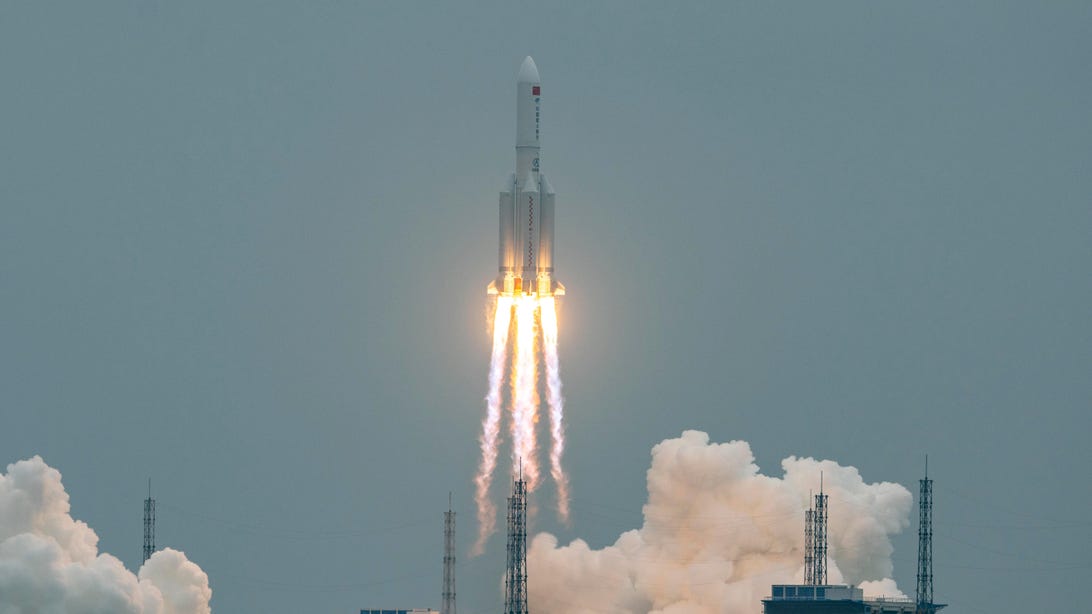[ad_1]

The Long March 5B launched the China Space Station core module in April. The rocket is now spiralling back to Earth.
China News Service/Getty
It sounds like the plot of a Bruce Willis movie. The US Pentagon says it’s tracking a large Chinese rocket body that’s out of control and expected to reenter Earth’s atmosphere this weekend. The problem? While we know the big body is definitely coming down, we don’t know exactly where.
The US Space Command is tracking the trajectory, Defense Department spokesperson Mike Howard said in a statement cited by CNN, and expects the Chinese Long March 5B rocket’s appearance “around May 8.”
Howard said the rocket’s exact entry point won’t be known until within hours of reentry, but daily updates on its location will be provided at the Space Track website.
Aerospace.org is also tracking the rocket, and as of Friday evening, was predicting a May 8 arrival, around 9:19 p.m. PT, though predictions may change.
Want to see it? Gianluca Masi of Ceccano, Italy, managed to capture an image, which he shared on his Virtual Telescope Project 2.0 website.
At the time the image was taken, “the rocket stage was at about 700 kilometers (434.9 miles) from our telescope, while the sun was just a few degrees below the horizon, so the sky was incredibly bright,” Masi wrote. “This is huge debris (22 tons, 30 meters/98 feet long and 5 meters/16 feet wide), but it is unlikely it could create serious damage.”
In fact, Jonathan McDowell, an astrophysicist at the Astrophysics Center at Harvard University who tracks and catalogues satellite orbits, told CNN “the risk that it will hit you is incredibly tiny. And so I would not lose one second of sleep over this.”
Because the Pacific Ocean covers so much of Earth, the debris will likely splash down in Pacific waters somewhere, he said.
McDowell also adjusted the time period when the debris is expected to arrive.
This morning’s data on the altitude-versus-time of the Tianhe / CZ-5B objects. The core stage orbit continues to slowly decay as expected. pic.twitter.com/E8EPJ9yzRu
— Jonathan McDowell (@planet4589) May 4, 2021
The rocket helped launch Tianhe, the core module in China’s new, next-generation space station, on April 28. The space base is scheduled to be completed late in 2022 to serve as a scientific research outpost for China over the next decade, and it will be the only other operational space habitat outside of the International Space Station.
How did this happen?
Typically, what goes up, must come down.
Back in 2018, similar events took place, when China’s out-of-control Tiangong-1 space station reentered the atmosphere over the ocean near Tahiti. No one was injured, and the debris either burned up or found a new home on the floor of the south Pacific.
When space agencies launch large rockets, they typically don’t reach orbit — they’re designed to fall back into the ocean. Other times, rockets and satellites have built in mechanisms to deliberately deorbit them and guide them back to Earth safely. Many have been deliberately tossed into the so-called “spacecraft cemetery,” a huge, uninhabited area of the Pacific Ocean. It’s one of the furthest locations on the planet from any land.
The rocket that carried Tianhe made it into orbit and once its engines shut down, was captured by Earth’s gravity. Drag on the rocket sees its orbit slowly decay. Each rotation around the Earth brings it closer to a point where it ultimately slams into the atmosphere at speed — “reentry” — and burns up.
However, it’s not just about what comes down. Space junk, discarded rocket boosters, scraps of metal and defunct satellites, can remain in orbit for years — even decades. Almost 3,000 satellites are in orbit and remain in operation, but almost three times that amount are defunct.
“As we’ve launched more and more satellites into space, the problem has gotten progressively worse,” James Blake, an astrophysicist Ph.D. student at the University of Warwick studying orbital debris, told CNET last November.
As of April 5, McDowell suggests we still don’t know where the booster will come down but it’s return is likely to occur on May 8 or 9.
And no, we still don’t know *where* it’s going to come down. Uncertainty on *when* is still ‘sometime Saturday or Sunday’.
— Jonathan McDowell (@planet4589) May 6, 2021
On April 6, U.S. defense secretary Lloyd Austin said the US doesn’t “have a plan to shoot the rocket down” and is hopeful it will “land in a place where it won’t harm anyone.”
Follow CNET’s 2021 Space Calendar to stay up to date with all the latest space news this year. You can even add it to your own Google Calendar.
[ad_2]
Source link